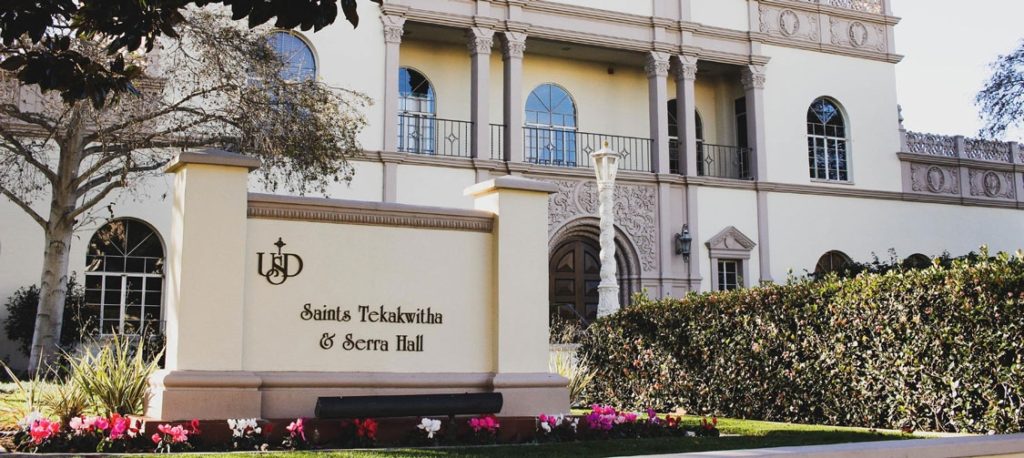Honoring the Kumeyaay Nation
It’s time that USD takes more action to honor the history of the land it resides on
Maria Simpson / Assistant Opinion Editor / The USD Vista

Photo courtesy of The USD Vista
October is a month full of big occasions, from Halloween to Filipino American Heritage Month and midterms at USD. One of the lesser known, but incredibly important days this month, is Indigenous Peoples’ Day on Oct. 11. This is a day to celebrate the Indigenous People of America, who are so often forgotten and neglected, even until now.
As this day passed by, it made me look at USD’s relationship with the Kumeyaay
Nation with open eyes and wonder if the university is really doing enough to honor the stolen land that we reside on.
Within the past few years, USD has done some work to acknowledge the Kumeyaay Nation – the Indigenous tribe of this region – whose unceded territory is the land that USD is built on. Part of this work includes removing offensive language on campus. For example, Valley A and Valley B used to be called Missions A and B. That name was changed due to the dark history of the Catholic missions’ treatment of Indigenous people.
Mata’yuum Crossroads, once called Mission Crossroads, was also changed to include the language of the Kumeyaay Nation (Mata’yuum means “gathering place”) on our campus alongside English and Spanish. In 2017, USD also cultivated the Kumeyaay Garden, located behind the University Center at the edge of campus, featuring a number of native plants that were used by Indigenous People in this area. Arguably the most well known and most controversial change to the campus, in an effort to acknowledge the history of Indigenous Peoples, was adding the name of Saint Tekakwitha to Serra Hall. Saint Tekakwitha was a member of the Mohawk people who converted to Catholicism despite criticism. She was the first Native American to be recognized as a saint.
The change to this building’s name was a result of student protests, asking for Serra’s name to be dropped entirely from the title. Junipero Serra was a Spanish priest who came to the Americas to establish missions in California and spread the Catholic faith. In 2015, Pope Francis officially canonized him as a saint, but Serra has since been the subject of much debate, due to his controversial history. Serra brought Catholicism to Native Americans, which his supporters commend him for, but in doing so he stood by and allowed the abuse and enslavement of Indigenous People in the missions that he founded. The university decided that, while it would be too difficult to remove Serra altogether since he was a new saint, Saint Tekakwitha was added to the building’s name.
Adding Saint Tekakwitha to the building name was a step forward, but it was a step forward on a long road ahead. Progress is often slow and gradual, but I think that it is time for USD to reevaluate Serra’s name on the building, as well as what more they can do to better honor the Kumeyaay tribe.
I find the idea of having the names of a Native American saint and a saint involved in colonization next to one another problematic. It was people like Junipero Serra who destroyed the homes, traditions, and families of people like Saint Tekakwitha. While Serra helped spread Catholicism, his methods of doing so were inhumane and unjust. Social justice is a value that the Catholic Church and USD share, and that should be promoted first and foremost. Eliminating Serra’s name altogether is one of the best ways that USD can demonstrate their solidarity with Indigenous People right now.
Changing the name of Saints Tekakwitha and Serra Hall should be the next step on the path toward better acknowledgment of Indigenous People, but there is more that USD should do. Making students more aware of our land acknowledgment and the history of the Kumeyaay nation in San Diego is another necessary step. I was not aware of what the names of certain buildings meant or even who the Kumeyaay Nation was until I heard it discussed on campus very recently and did some research into the university’s actions.
There are so many ideas that USD could put into action. Land acknowledgements at the beginning of the school year would be an easy and impactful idea. Although USD has a land acknowledgment statement, none of my classes shared it this year so it is not truly being of use. Displaying plaques with information in locations such as the Kumeyaay Garden would also help open students’ eyes to the significance of those names and features around campus. Plaques would be a nice permanent reminder, but there should also be activities to attract more student involvement. USD could hold a celebratory event to share the history of the Kumeyaay tribe and draw students’ attention to participate and educate themselves through the event.
Not only should the school itself work to better communicate the history of the land USD is built on, the Kumeyaay Nation should have the chance to share their own history. In San Diego County, there are currently 18 federally recognized Native-American reservations. These individuals have so much history and wisdom to share, but they are often forgotten and shoved into the background, as if they themselves are history. But these men and women are anything but history. They exist here with us, and they deserve the chance to share with us who they are and what would make them feel welcomed and acknowledged on our campus.